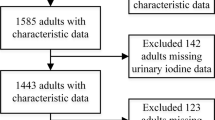Abstract
This study was performed to investigate the status of serum iodine concentration among the Budd–Chiari syndrome (BCS) patients and its effect on thyroid hormone. The study group serum specimens were collected from 233 BCS patients and 60 healthy people. Serum iodine was analyzed with the Sandell–Kolthoff method, and the ELISA method was used to detect thyroid function: TSH, T3, T4, FT3, and FT4. The serum iodine level of patients with BCS was 316.7 ± 256.8 μg/L, greatly higher than 76.3 ± 25.7 μg/L of serum iodine for control group (p < 0.001), but with no significant difference among different types of BCS. There were no statistically significant differences in thyroid hormone levels (TSH, T3, T4, FT3, and FT4) between people with BCS and control group, although the TSH level of BCS group is slightly higher than that of normal control group. This study demonstrates that iodine may be related to the pathogenesis of BCS and needs to be paid more attention.

Similar content being viewed by others
References
Hoekstra J, Janssen HL (2008) Vascular liver disorders (I): diagnosis, treatment and prognosis of Budd–Chiari syndrome. Neth J Med 66:334–339
Brancatelli G, Vilgrain V, Federle MP, Hakime A, Lagalla R, Iannaccone R, Valla D (2007) Budd–Chiari syndrome: spectrum of imaging findings. AJR Am J Roentgenol 188:168–176
Bayraktar UD, Seren S, Bayraktar Y (2007) Hepatic venous outflow obstruction: three similar syndromes. World J Gastroenterol 13:1912–1927
Lupescu IG, Dobromir C, Popa GA, Gheorghe L, Georgescu SA (2008) Spiral computed tomography and magnetic resonance angiography evaluation in Budd–Chiari syndrome. J Gastrointestin Liver Dis 17:223–226
Qiao T, Liu CJ, Liu C, Chen K, Zhang XB, Zu MH (2005) Interventional endovascular treatment for Budd–Chiari syndrome with long-term follow-up. Swiss Med Wkly 135:318–326
Zhuang Y, Zu M, Zhang Q (2011) Epidemiological investigation of 1148 patients with Budd–Chiari syndrome. Chin J Gen Surg 20:614–617
Uvaraj P, Rathisharmila R, Ilamaran V (2013) Protein C and protein S deficiency presenting as Budd–Chiari syndrome. Blood Coagul Fibrinolysis 24:652–654
Qi X, De Stefano V, Wang J, Bai M, Yang Z, Han G, Fan D (2013) Prevalence of inherited antithrombin, protein C, and protein S deficiencies in portal vein system thrombosis and Budd–Chiari syndrome: a systematic review and meta-analysis of observational studies. J Gastroenterol Hepatol 28:432–442
Boskovic A, Kitic I, Stankovic I, Prokic D, Zlatar N (2014) Primary Budd–Chiari syndrome in a 3-year-old boy with homozygous factor V Leiden G1691A mutation. Eur J Pediatr 173:393–395
Toyama K, Karasawa M, Yamane A, Koiso H, Yokohama A, Uchiumi H, Saitoh T, Handa H, Sato K, Takagi H, Miyawaki S, Murakami H, Nojima Y, Tsukamoto N (2009) Low burden of a JAK2-V617F mutated clone in monoclonal haematopoiesis in a Japanese woman with Budd–Chiari syndrome. Int J Hematol 89:517–522
Nakase H, Kawasaki T, Itani T, Mimura J, Komori H, Okazaki K, Chiba T (2001) Budd–Chiari syndrome and extrahepatic portal obstruction associated with congenital antithrombin III deficiency. J Gastroenterol 36:341–345
Pei-rui XIAO, Xin-ying LIN, Cheng-hao GUO (2011) Study of correlation between the geographical distributions of Budd–Chiari syndrome with iodine content in drinking water. J Clin Hepatol 27:130–133
Melse-Boonstra A, Mackenzie I (2013) Iodine deficiency, thyroid function and hearing deficit: a review. Nutr Res Rev 26:110–117
Lu X, Xu K, Zhang QQ, Yang C, Li SD, Li JS, Rong YT, Zhu MH (2011) Study on between magnetic resonance venography and digital subtraction angiography on the inferior vena cava obstructive interface morphology of Budd–Chiari syndrome. Zhonghua Gan Zang Bing Za Zhi 19:923–926
Bunyamin B, Mine G, Mustafa G (2009) Iodine and magnesium levels in maternal and umbilical cord blood of preeclamptic and normal pregnant women. Biol Trace Elem Res 129:1–8
Burgi H (2010) Iodine excess. Best Pract Res Clin Endocrinol Metab 24:107–115
Wang Y, Zhang H, Guo C, Fan Q (2008) Pathologic and etiologic studies of membrane obstruction of the inferior vena cava in Budd-Chiari syndrome. J Interv Radiol 17:500–502
Hua Q, Zu M, Teng F, Wei N, Hu L (2013) Research on the relationship between bFGF, FGFR2 and the fibroblast proliferation promoted by high density iodine. J Interv Radiol 22:1016–1020
Zhou H, Xu H, Zu M (2008) Relationship between the impact of blood flow, diaphragm movement and the pathogenesis of membranous obstruction of inferior vena cava. J Interv Radiol 17:729–733
Acknowledgments
The study was supported by the grants from the Clinical Medical Science and Technology Project of Jiangsu Province (BL2012021, BL2012044) and in part by the Nature Science Fund for Colleges and Universities in Jiangsu Province (12KJD310007).
Author information
Authors and Affiliations
Corresponding authors
Rights and permissions
About this article
Cite this article
Zhuang, Y., Zu, M., Li, J. et al. Serum Iodine Is Increased in Subjects Having Budd–Chiari Syndrome. Biol Trace Elem Res 168, 21–24 (2015). https://doi.org/10.1007/s12011-015-0343-2
Received:
Accepted:
Published:
Issue Date:
DOI: https://doi.org/10.1007/s12011-015-0343-2




